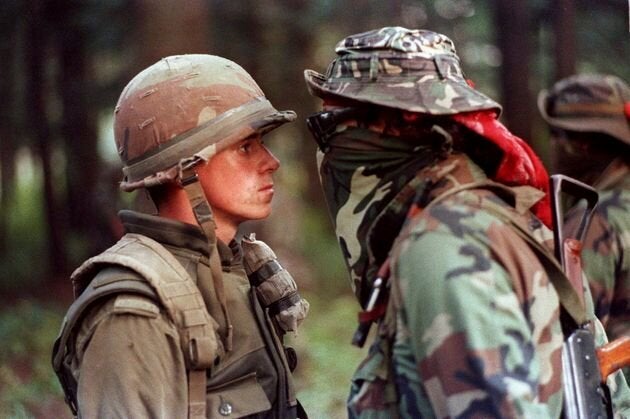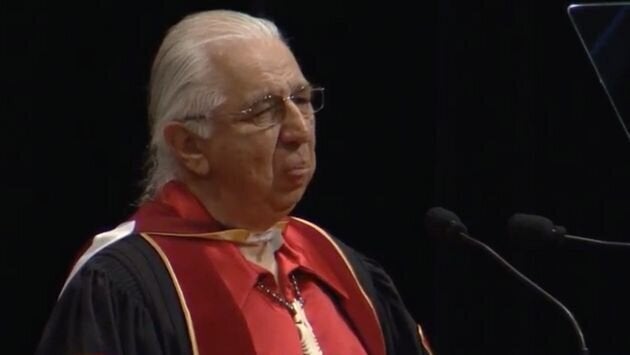MONTREAL — As the rail blockades that have paralyzed cross-country transportation enter their third week, a growing number of commentators are drawing comparisons with the spectre of the Oka crisis. Thirty years after that dark period in Canada’s relationship with Indigenous Peoples, what have governments learned?
“It’s obvious that political authorities are traumatized, with reason, by the events of 1990. They don’t want to go through this again,” says Éric Cardinal, course lecturer at the University of Montreal and vice-president of Indigenous consulting firm Acosys.
Cardinal told HuffPost Québec he believes it’s the memory of the Oka Crisis that held governments back from forcibly dismantling the rail blockades up to this point.
“Today, we’re a lot more conscious of the colonial heritage. We understand that Indigenous Peoples form Nations. And when we’re dealing with different Nations, using firearms is equivalent to a declaration of war,” explains Pierre Trudel, associate researcher with the Canada Research Chair in Quebec and Canadian Studies and Oka crisis expert.
“The government learned not to pick a fight with us,” summarizes Kenneth Deer secretary of the Mohawk Nation at Kahnawake and member of the Haudenosanee external relations committee.
And while the Royal Canadian Mounted Police did intervene in British Columbia to dismantle Wet’suwet’en camps, Éric Cardinal believes authorities will be more wary of taking action against camps in Kahnawake and Tyendinaga, in Ontario.
“As soon as it touches Mohawk territories, I think we become a lot more cautious,” says Cardinal, since Mohawks were at the heart of the Oka crisis.
The Oka crisis revisited
In the summer of 1990, Oka mayor Jean Ouellette’s plan to expand the municipal golf course on the site of a Mohawk cemetery and develop luxury condos there sent the province into a crisis that lasted 78 days.
To prevent the project from going forward, a militant group from the Kanesatake reserve, nicknamed the Warriors, erected a barricade to block access to a forested area on unceded Mohawk territory. The area would become known as ‘The Pines.’

On July 11, 1990, at the mayor’s request, the Sûreté du Québec (SQ) intervened to dismantle the barricade and enforce an injunction granted by the Superior Court of Québec. Shots were fired on both sides and SQ Cpl. Marcel Lemay is killed. On the other side of the St. Lawrence River, in Kahnawake, another group of Warriors blocked the Mercier Bridge in solidarity with Kanesatake. It marked the beginning of the Oka crisis.
The siege lasted 78 days. Indigenous supporters from all over the country joined the blockade, turning the conflict into a national crisis.
In August, at the behest of then-Quebec premier Robert Bourassa, the Canadian army took over from the SQ. Four thousand soldiers with tanks and helicopters were positioned around Kahnawake and Kanesatake. Over the next several weeks the army advanced, bulldozing the barricades on Sept 2nd. The crisis ended on Sept. 26, when the Warriors surrendered.
Unceded territory
Many experts say the Oka Crisis has made the population more aware of Indigenous Peoples’ traditional rights and territorial claims.
“Before Oka, most people didn’t even know that Kahnawake and Kanesatake existed. So close to Montreal, and yet they knew nothing about us,” Kenneth Deer, a member of the Mohawk Nation at Kahnawake, remembers. “Afterwards, people learned a lot about Indigenous Peoples, about our rights, about Mohawks…”
But more work needs to be done.
“After the Oka Crisis, the Royal Commission on Aboriginal Peoples made recommendations, just like the Truth and Reconciliation Commission and the National Inquiry into Missing and Murdered Indigenous Women and Girls. Those recommendations need to be followed by the government instead of being put on a shelf,” Deer told HuffPost.
The question of unceded territories, regions of Canada that aren’t covered by any treaties with First Nations, is at the heart of the current crisis. And with it, the question of how much authority sits with traditional Indigenous governments, such as the hereditary chiefs of Wet’suwet’en.
Yet one of the recurring recommendations of the reports was to “pay attention to these governments that Canada has been ignoring for a hundred years,” says Deer.
“The elected governments are creations of the Canadian government,” he points out. “The Canadian government created them to destroy our culture, our language, our history, and our inherent rights that we have from time immemorial to the land and the territory.”
“I’m surprised that it’s taking so long for a dialogue to be established with the hereditary chiefs,” says Cardinal. “The hereditary chiefs of Wet’suwet’en are legitimate. It’s a mode of governance that has been recognized by the Supreme Court.”

Cardinal and Deer both believe that the first step to resolve the crisis is the withdrawal of RCMP agents from Wet’suwet’en territory. On Thursday morning, in a letter to hereditary chiefs, the RCMP offered to pull out from the road leading to the Coastal GasLink construction sight. The offer is conditional upon “the road remaining clear,” said federal Public Safety Minister Bill Blair.
“When the Wet’suwet’en chiefs are satisfied, our barricades will come down,” assures Deer, commanding the patience of those affected by the rail blockades.
“If there is one thing we learned from Oka, it’s that things take time,” says Trudel.
He believes it is unlikely the crisis will last as long as the one in 1990, because the economic impacts of the blockades are much greater. The “saturation point” will be reached a lot quicker.
“The Trudeau government will be like the [provincial] Bourassa government,” Trudel says. “If he sees he’s about to lose the power, he’ll act.”
The climate question
While there are many similarities between the Oka crisis and the current conflict, a new reality that could throw a wrench in the works: the climate crisis.
Throughout the country, Indigenous protesters have received support from groups opposing the fossil fuel industry. This week, during two protests in Montreal in solidarity with Wet’suwet’en, climate change was part of the organizers’ motivation.
See photos of the protest in our gallery below:
When she visited Montreal last September, Greta Thunberg requested that representatives of the First Nations open the march. “A strong symbol,” notes Trudel.
Kenneth Deer agrees. “It’s not only about the rights of the people of Wet’suwet’en. It’s also about climate change.”
He’s not overly worried about the climate question outshining the territorial claims of the Wet’suwet’en, though.
“Of course, there has to be a balance between the rights of Mother Earth and the rights of the Peoples. In this case, the sovereignty issue and the environmental issue are all rolled up into one,” he says.
Also on HuffPost:
